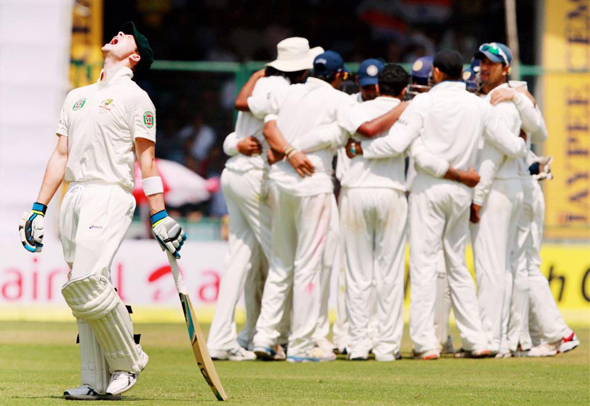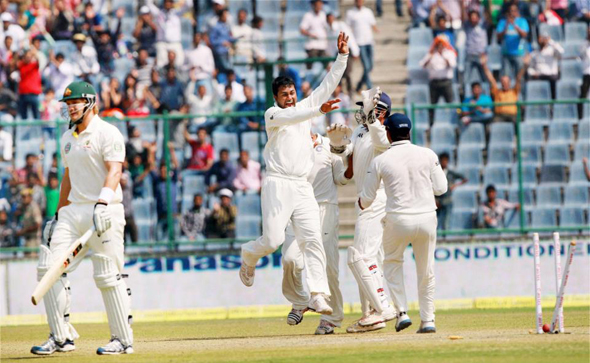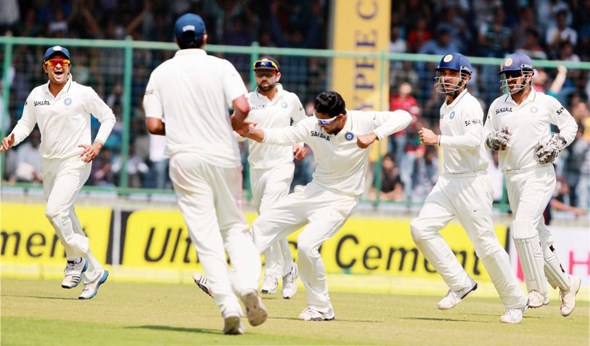
On a Feroze Shah Kotla track which is not conducive for good batting, India chased down a tricky target of 155, largely due to Cheteshwar Pujara's dazzling strokeplay as the home team recorded their biggest ever series win in the 81-year history inside three days.
Pujara, who was battling pain as he was playing with a swollen hand, enthralled one and all with his perfect technique on a rank turner, scoring a brilliant unbeaten 82 off 92 balls with 11 boundaries.
For Australia, it was the first time in 43 years to suffer a 0-4 series whitewash after Bill Lawry's side did the same in South Africa in 1969-70.
There were a few jitters when India lost Virat Kohli (41), Sachin Tendulkar (1)and Ajinkya Rahane (1) in quick succession but Pujara kept his cool in company of skipper Mahendra Singh Dhoni (8 not out) to successfully complete the run chase.
Pujara hit three boundaries off Glenn Maxwell to level the scores and then Dhoni hit the winning boundary to send the 25,000-odd crowd at the stadium into a frenzy.
The on-field celebrations were muted but the dressing room was delirious with joy as the players engaged in bear hugs.
The target of 155 might have looked quite a task but both Pujara and Kohli made batting look easy on a difficult track, adding 104 runs for the second wicket to pave the way for victory.
Starting the run chase, Murali Vijay (11) was bowled trying to play an unnecessary reverse sweep but Pujara played some unorthodox shots to set the tone.
Pujara showed positive intent as he and Kohli scored at a brisk pace. The Saurashtra lad showed his stroke-making prowess as India reached their 50 in the ninth over.
Pujara played the sweep shot to good effect but his two best shots were played of Mitchell Johnson. First, he deliberately lobbed a Johnson bouncer over wicketkeeper Matthew Wade's head and then hit a fierce square-cut on the rise. The third boundary of the over was hit through the cover.
As if he was getting into the IPL mode, Pujara scored his second 50 of the match from just 54 balls and India's 100 was reached in 19 overs at a rate of more than five runs per over.
While Pujara stepped up the ante, Kohli was happy playing the second fiddle.
Inexplicably, Australian captain Shane Watson did not use leggie Steven Smith, who could have effectively used the rough, nor did he call James Pattinson or Peter Siddle to bowl to exploit some of the spots created at the Delhi Gate End.
Earlier, on the pitch prepared by Venkat Sundaram which resembled a minefield, Ravindra Jadeja (5/58) created terror in the minds of the Australian batsmen as he extracted vicious turn and bounce as they were all-out for 164 in their second innings.
Siddle produced another gutsy performance with the willow as he took the Indian attack by the scruff of its neck, scoring a 45-ball 50 with seven boundaries. His innings was a lesson for Australian top-order batsmen about the technique needed to survive on a treacherous track.
Incidentally, Siddle was the best Aussie batsman in both their innings as his effort meant that the visitors put up a score which could be considered decent enough on this kind of track. Jadeja first removed Glenn Maxwell, who was sent up the order to open the innings. Maxwell (8) did not come fully forward to a delivery from Jadeja that pitched on the middle stump and turned a shade to hit the off-stump.
David Warner (8) was then trapped leg before in Jadeja's very next over as the batsmen played a length ball on the backfoot. He was caught plumbed in-front as the delivery would have hit the leg-stump.
The tension brewing between Jadeja and Warner came into the forefront once again as the Indian left-arm spinner gave the batsman a rude 'send-off' which could earn him a sanction from the match referee.
Phillip Hughes, who had two decent knocks under his belt, got a questionable decision when R Ashwin, coming round the wicket, trapped him on his back-pad. The television replays showed that the ball would have probably missed the off-stump. Hughes managed only six.
The normally dogged Ed Cowan (24, 5x4) employed a positive approach as defending on this track looked impossible. Most of the times, the tactic he used to counter Jadeja was to take a big stride forward to stop the ball from doing unusual tricks. He got a few boundaries in the process.
Stand-in captain captain Shane Watson hit a lovely on-drive but then played a rash shot off an innocuous delivery from Pragyan Ojha. Watson rocked on the backfoot to pull a short delivery and missed the line to get bowled.
The score was 51 for four at that stage but within two runs, Cowan was gone as Jadeja pitched one on the good length and turned enough to catch the left-hander on the backfoot. Within first 20 overs of the Australian second innings, the top five were back in the hut.
The post-lunch session saw Steven Smith and Johnson being removed by Jadeja off successive deliveries but two crucial stands of 28 and 35 for eighth and ninth wickets respectively -– both involving Siddle -- helped the visitors cross 150.
In the morning, it took only eight minutes and 13 deliveries to polish off the Indian tail as Nathan Lyon got his career-best figures of 7 for 94 as the home side managed a slender lead of 10 runs.







Comments
Add new comment